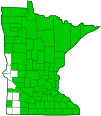gray dogwood
(Cornus racemosa)
Conservation • Wetland • Description • Habitat • Ecology • Use • Distribution • Taxonomy
Description |
||
Gray dogwood is an erect, perennial shrub that rises on multiple stems. It can be up to 16′ tall and up to 1½″ in diameter, but is usually much shorter. It rises from a shallow, spreading, woody root system. The central and side roots have buds which may sprout and form above-ground stems (suckers). When conditions permit, it forms colonies which may become large and dense. The stems are erect to arched. In a colony, the middle stems tend to be upright while those on the periphery are arched, forming a rounded clump. First-year twigs are slender, orangish-brown, and smooth to the touch. They are not streaked or spotted. They are hairless or sparsely covered with appressed hairs. Second-year twigs are slender, gray, hairless, and slightly rough to the touch due to small, pale, slightly raised dots (lenticels). The common name of this plant refers to the color of the twigs. The pith is solid and whitish or tan. The leaf scars are narrow, U-shaped, and slightly raised. Each leaf scar has three bundle scars and is connected by a thin line to the leaf scar on the opposite side of the twig. The terminal bud is egg-shaped and is covered by two sharply pointed, abutting but not overlapping scales. The scales have whitish tips, appearing frosted. Lateral buds are similar but smaller. The bark on young stems is gray and smooth or somewhat rough and shallowly fissured. On older stems the bark is grayish-brown, rough, and divided into thin, irregular plates. The leaves are opposite, deciduous, and evenly distributed along the branch. The leaf stalk is slender, sparsely covered with minute hairs or almost hairless, and 3 ⁄16″ to ⅝″ long. The leaf blade is egg-shaped, elliptic, or inversely egg-shaped, 2″ to 3½″ long, and ¾″ to 1¾″ wide. It is tapered at the base and tapered to a sharp point at the tip with concave sides along the tip. On each side of the midrib there are usually 4, sometimes only 3, conspicuous veins that curve upward toward the tip of the leaf. The upper surface is dark green or green and hairless or sparsely to moderately covered with straight, mostly appressed, T-shaped hairs. The lower surface is pale or whitened, slightly rough to the touch, but otherwise similar to the upper surface. The margins are untoothed. The leaves turn reddish or purplish in the fall. The inflorescence is a dense, pyramid-shaped, branched, cluster (panicle) of 20 to 75 flowers at the ends of branches. The panicle is ¾″ to 1½″ tall and 1¼″ to 2″ wide, about as tall as wide. The flowers are on stout, cream-colored, hairless or sparsely hairy, 1 ⁄16″ to ¼″ long stalks (pedicels). They reach peak flowering time in early June to early July. Each flower has four sepals, four petals, four stamens, and a well-developed style. The sepals are fused for most of their length and separated at the tip into four minute teeth. The petals are white or creamy white, narrowly oblong lance-shaped, and ⅛″ to 3 ⁄16″ long. The stamens have long cream-colored filaments and white or yellowish anthers. The style is slender, cream-colored, 1 ⁄16″ to ⅛″ long. The fruit is a berry-like, 3 ⁄16″ to 5⁄16″ in diameter drupe with one or two seeds. It is green initially, turning white or light blue. It matures in early August to early September. The pedicels become bright red in fruit and persist and remain red well into winter. |
||
Height |
||
6′ to 16′ |
||
Flower Color |
||
White |
||
Similar Species |
||
Red osier dogwood (Cornus sericea ssp. sericea) first- and second-year twigs are red, greenish-red, or grayish-green. Bark and twigs turn red in winter. The pith is white. The leaf stalks areup to 1″ long and are hairy. The leaves have no more than five or six veins per side. The leaf undersides are glaucous. Silky dogwood (Cornus obliqua) second-year twigs are greenish-purple, purplish, or reddish-purple. The pith of second year in older twigs is brown. The leaf blades have usually 5, sometimes 4, pairs of lateral veins. The underside of the leaf may be pale green but is not whitened. The inflorescence is wider than tall, flat-topped to shallowly convex, not pyramidal. The fruit is pale blue with white patches, becoming dark blue at maturity. |
||
Habitat |
||
Moderate moisture to somewhat dry. Open hardwood forests, forest edges, forest openings. Partial sun. Moderately shade tolerant. |
||
Ecology |
||
Flowering |
||
Early June to early July |
||
Pests and Diseases |
||
|
||
Use |
||
|
||
Distribution |
||||
|
Sources |
|||
| 2/24/2023 | ||||
Nativity |
||||
Native |
||||
Occurrence |
||||
Common |
||||
Taxonomy |
|||
| Kingdom | Plantae (Plants) | ||
| Subkingdom | Pteridobiotina | ||
| Phylum | Tracheophyta (Vascular Plants) | ||
| Class | Magnoliopsida (Dicots) | ||
Order |
Cornales (dogwoods, hydrangeas, and allies) | ||
Family |
Cornaceae (dogwood) | ||
| Subfamily | Cornoideae | ||
Genus |
Cornus (dogwoods) | ||
| Subgenus | Kraniopsis | ||
Subordinate Taxa |
|||
|
|||
Synonyms |
|||
Cornus foemina ssp. racemosa Cornus paniculata |
|||
Common Names |
|||
gray dogwood grey osier dogwood northern swamp dogwood panicled dogwood |
|||
Glossary
Bundle scar
Tiny raised area within a leaf scar, formed from the broken end of a vascular bundle.
Drupe
A fleshy fruit with a single hard, stone-like core, like a cherry or peach.
Glaucous
Pale green or bluish gray due to a whitish, powdery or waxy film, as on a plum or a grape.
Lenticel
A corky, round or stripe-like, usually raised, pore-like opening in bark that allows for gas exchange.
Panicle
A pyramidal inflorescence with a main stem and branches. Flowers on the lower, longer branches mature earlier than those on the shorter, upper ones.
Pedicel
On plants: the stalk of a single flower in a cluster of flowers. On insects: the second segment of the antennae. On Hymenoptera and Araneae: the narrow stalk connecting the thorax to the abdomen: the preferred term is petiole.
Pith
The spongy cells in the center of the stem.
Sepal
An outer floral leaf, usually green but sometimes colored, at the base of a flower.
Sucker
A basal shoot rising from the roots or from a bud at the base of a shrub or tree.
Visitor Photos |
|||||
Share your photo of this plant. |
|||||
| This button not working for you? Simply email us at info@MinnesotaSeasons.com. Attach one or more photos and, if you like, a caption. |
|||||
|
|||||
MinnesotaSeasons.com Photos |
|||||
Plant |
|||||
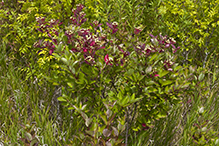 |
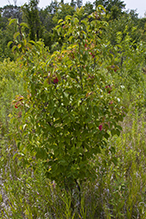 |
||||
Inflorescence |
|||||
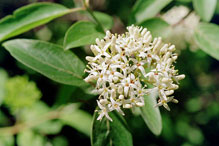 |
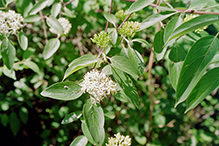 |
||||
Leaves |
|||||
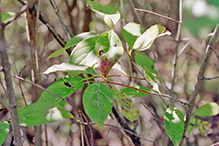 |
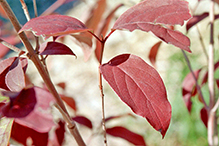 |
||||
Stem |
|||||
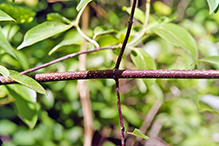 |
|||||
Infructescence |
|||||
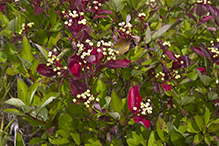 |
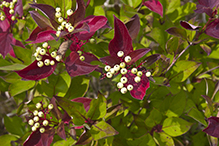 |
||||

Slideshows |
||
| Gray Dogwood Andree Reno Sanborn |
||
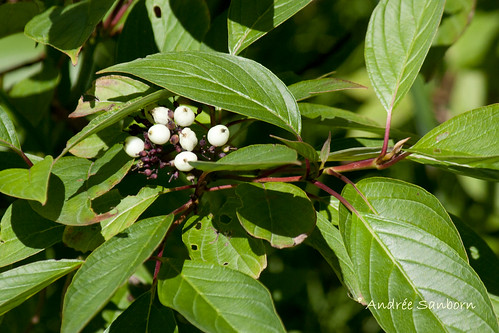
|
||
About
Cornus racemosa |
||
| Cornus racemosa GRAY DOGWOOD Frank Mayfield |
||
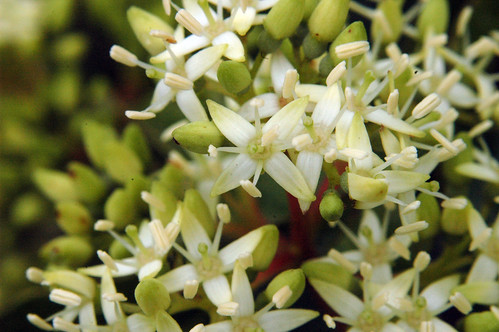
|
||

Visitor Videos |
|||
Share your video of this plant. |
|||
| This button not working for you? Simply email us at info@MinnesotaSeasons.com. Attach a video, a YouTube link, or a cloud storage link. |
|||
Other Videos |
|||
| EcoBeneficial Tips: Spotlight on Gray Dogwood Kim Eierman |
|||
About
Published on Sep 15, 2013 Learn about one of our great native shrubs, Gray Dogwood (Cornus racemosa), which supports many pollinating insects and song birds. For more useful gardening tips to improve our environment visit: http://www.ecobeneficial.com/ |
|||
| Gray dogwood TheCampusTrees |
|||
About
Published on Apr 16, 2014 Special Thanks to: Philip Potyondy Produced by: |
|||

Visitor Sightings |
|||||
Report a sighting of this plant. |
|||||
| This button not working for you? Simply email us at info@MinnesotaSeasons.com. Be sure to include a location. |
|||||
|
|||||
MinnesotaSeasons.com Sightings |
|||||
Avon Hills Forest SNA, North Unit Carpenter St. Croix Valley Nature Center Charles A. Lindbergh State Park Forestville/Mystery Cave State Park John Peter Hoffman Spring Brook Valley WMA Minnesota Valley NWR, Long Meadow Lake Unit Minnesota Valley NWR, Louisville Swamp Unit Minnesota Valley NWR, Wilkie Unit Minnesota Valley State Recreation Area, Lawrence Unit Mound Spring Prairie SNA, North Unit Nerstrand Big Woods State Park Northern Tallgrass Prairie NWR, Rengstorf Unit Pankratz Memorial Prairie, North Unit Prairie Creek WMA, Koester Prairie Unit Sand Prairie Wildlife Management and Environmental Education Area |
|||||

|
Created: Last Updated: © MinnesotaSeasons.com. All rights reserved. |
